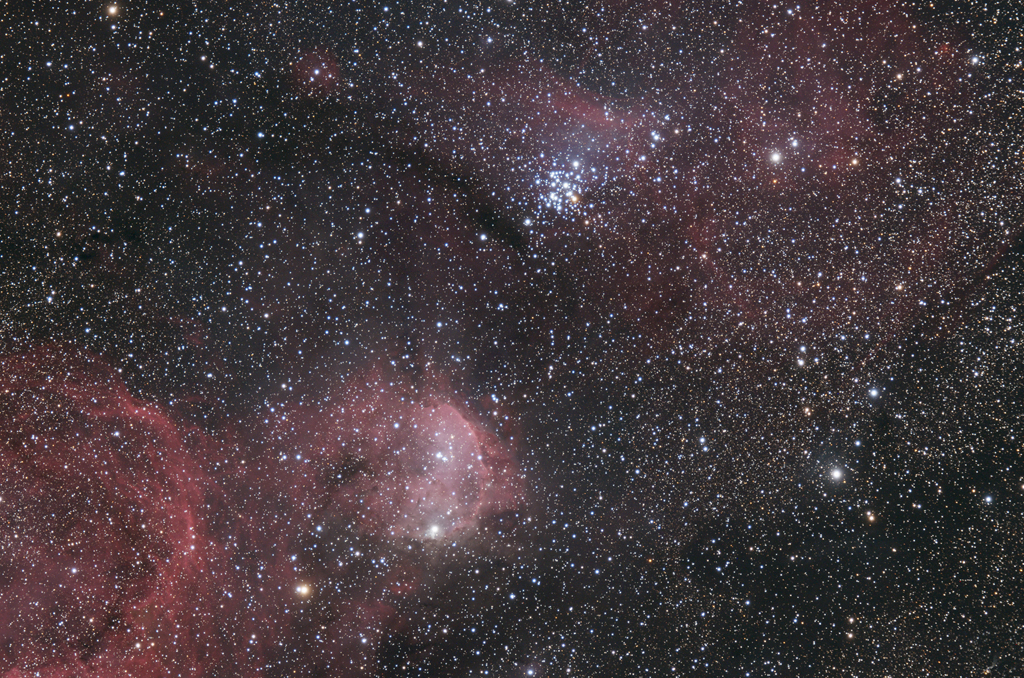 |
CHAMÄLEON + ONJALA OBSERVATORY DeepSky | SITEMAP HOME CHAMÄLEON |
|
 |
|||
| « zurück zur Startseite
galaktische Nebel « back to home galactic nebula |
Großes Bild laden - load large
image 2048
x 1400 Pixel Aufnahmedaten Image data |
NGC 3293 + NGC 3324 (+ IC 2599) - Star formation in the constellation Carina

NGC 3293 und NGC 3324 NGC 3293 ist wohl einer der schönsten offenen Sternhaufen am Südhimmel. Er steht im Sternbild Carina und es ist einer der hellsten Sternhaufen am südlichen Himmel und bereits mit dem bloßen Auge sichtbar. Vermutlich sind die die meisten, wenn nicht sogar alle der fünfzig Sterne des Haufens gleichzeitig vor weniger als 10 Millionen Jahren entstanden sind. NGC 3293 ist etwa 8.000 Lichtjahre vom Sonnensystem entfernt und wird nach Trumpler der Klasse I 3 r n zugeordnet. Die rötlichen H-II Regionen nördlich des Sternhaufen werden als GUM 30 (RCW 51) katalogisiert. NGC 3293 wurde vom französischen Astronomen Nicolas Louis de Lacaille während seines Aufenthalts in Südafrika im Jahr 1752 entdeckt. Weitere Informationen der ESO finden Sie hier.
NGC 3324
Südöstlich von NGC 3293 liegt NGC 3324, ein Emissionsnebel, der einen sehr jungen offenen Sternhaufen im südlichen Teil des Nebels beinhaltet. Er ist mit dem Emissionsnebel IC 2599 eng verbunden. Die NGC 3324 wurde am 1. Mai 1826 von James Dunlop entdeckt. Weitere Informationen der ESO sind hier zu finden. NGC 3324 war auch eines der ersten Testbilder, die das James Web Teleskop aufgenommen hat.
Object description
NGC 3293 und NGC 3324 NGC 3293 is probably one of the most beautiful open star clusters in the southern sky. It is located in the constellation Carina and it is one of the brightest star clusters in the southern sky and already visible to the naked eye. Probably most, if not all, of the fifty stars of the cluster formed simultaneously less than 10 million years ago. NGC 3293 is about 8.000 light-years away from the solar system and is assigned to class I 3 r n according to Trumpler. The reddish H-II regions north of the cluster are cataloged as GUM 30 (RCW 51). NGC 3293 was discovered by French astronomer Nicolas Louis de Lacaille during his stay in South Africa in 1752.
More information from ESO can be found here.
Southeast of NGC 3293 lies NGC 3324, an emission nebula containing a very young open star cluster in the southern part of the nebula. It is closely associated with the emission nebula IC 2599. NGC 3324 was discovered by James Dunlop on May 1, 1826. More information from ESO can be found here. NGC 3324 was also one of the first test images taken by the James Web Telescope.
 |
Die
Region ist etwa 7.500 Lichtjahre vom Sonnensystem entfernt. Unser
kontrastverstärktes Zusatzbild zeigt, dass die ganze Region zwischen NGC
3293 und NGC 3324 von Emissions- und Reflexionsnebel gefüllt
ist. The region is about 7,500 light-years from the solar system. Our contrast enhanced additional image shows that the whole region between NGC 3293 and NGC 3324 is filled by emission and reflection nebulae. « Klicken Sie hier oder auf das Vorschaubild zum Laden eines großen Bildes mit Objektbezeichnungen. « « Click here or on the thumbnail to load a large image with object annotations. |
NGC 3293 + NGC 3324 (IC 2599) - Star formation in the constellation Carina
Image data
07.05.2022 - 28 x 300 s, ZWO ASI 071 Pro - Color (cooled)
Telescope: Astro Physics 130mm EDFS + Flattener at f = 850mm
Location: Chamäleon Observatory, Onjala Lodge, Namibia
Image acquisition and processing: DeepSkyStacker, PixInsight + Photoshop
 |
 |
 |
 |
 |
 |
 |
| Sonne | Mond | Sonnensystem | DeepSky | Weitwinkel | Verschiedenes | Spez. Projekte |